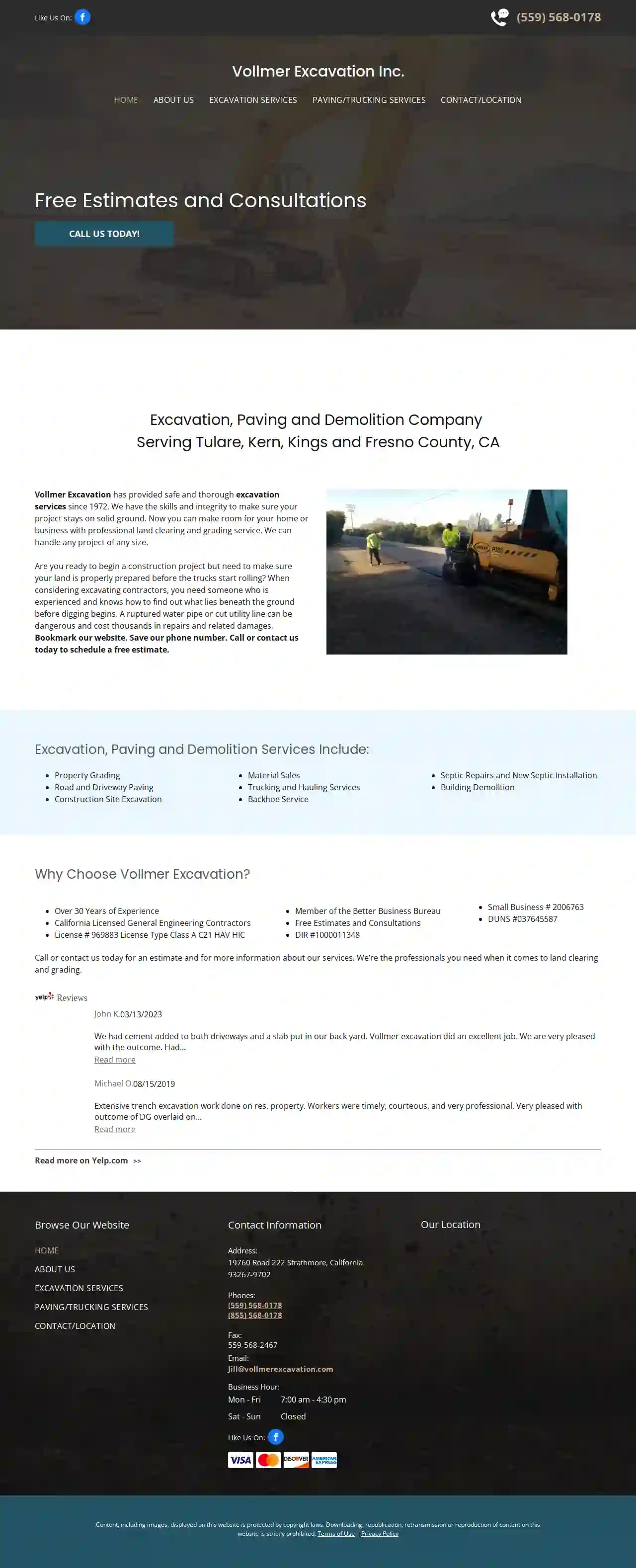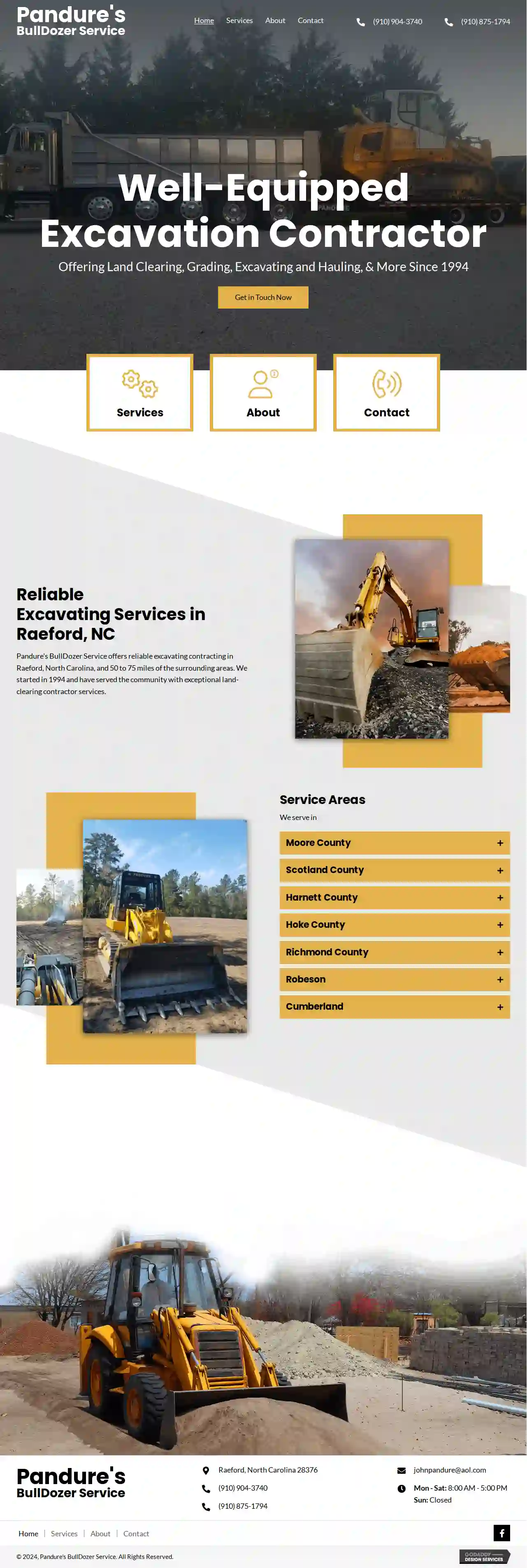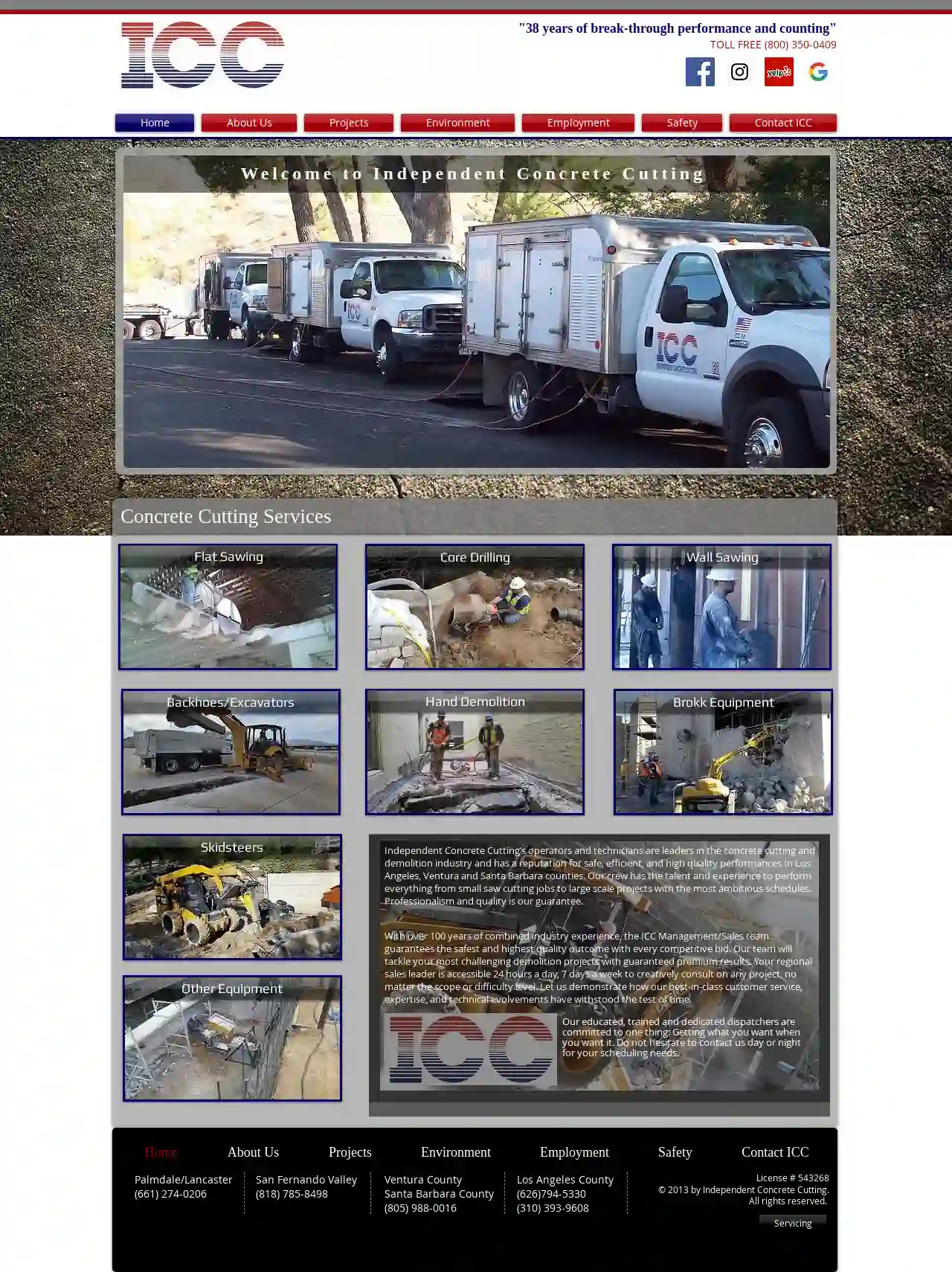Excavation Contractors Hercules
Find Excavating Contractors in Hercules
Receive 3 FREE Excavation Contractor quotes for your project today! Compare profiles, reviews, accreditations, portfolio, etc... and choose the best deal.

Geobear Foundation Repair
536 reviews22603 La Palma Suite 302, Yorba Linda, 92887, USRepair Your Foundation Issues At Their Source Loose and subsiding soils wreak havoc on foundations, causing cracking, settlement, and sinking slabs. Our geopolymer injection process repairs your compromised soils and restores load-bearing integrity. Learn How Geopolymer Injection Works We repair weak soils using a high density geopolymer that is specifically formulated for supporting foundations and concrete slabs. The geopolymer works by filling the voids present in the soils and underneath the slab, and then compacting it into dense matrix or geopolymer in soil. This process reestablishes the soils weight-bearing capacity and contact to your foundation slab. Precision and Excellence Over 200,000 structures treated worldwide We invented the geopolymer soil stabilization solution over 37 years ago, developing and refining the process that has been saving homes and foundations across the globe. The fact is our proprietary techniques, processes, diligence, and polymers are all built around our experiences, successes, and failures that make sure each and every project is done right. This is why our work is guaranteed for 10 years! What to expect from Geobear? Honesty, Professionalism, and a Hassle Free Experience. In our almost 4 decades of experience and over 200,000 projects, we've learned to make the soil repair process as easy an experience as possible. We help homeowners skip costly and disruptive processes that require excavation, heavy equipment, and weeks to months of installation time. Our geopolymer injection solution is so clean and easy that you don't have to move out and the work can be completed in 1-2 days. This means repairing your problem, completing the project in less time, and major cost savings. So why choose Geobear? Because it's a better way.
- Services
- Why Us?
- Testimonials
- Gallery
Get Quote
Roto-Rooter Plumbing & Water Cleanup
4.8275 reviewsRancho Cucamonga, USYour Local Roto-Rooter Plumber in Rancho Cucamonga, CA Roto-Rooter of Rancho Cucamonga is your trusted plumbing partner. We ride to the rescue 24/7, 365 days a year, to handle your most pressing plumbing needs, with our team of expert plumbers in Rancho Cucamonga to deliver a full range of services. From drain cleaning to complete sewer line repairs, we come fully licensed and insured for every plumbing challenge — and we serve both residential and commercial properties, no matter the size of the job. Roto-Rooter: America's Go-To Plumbing Provider Since 1935 Roto-Rooter has been America’s go-to, do-it-all plumbing provider since 1935. That’s why we're the premier plumber in Rancho Cucamonga, CA, with a long-standing reputation for quality that includes: Same day service 24/7 availability No hidden or extra charge for plumbing or drain service on holidays, nights, and weekends Onsite and upfront estimates Fully licensed, insured, experienced plumbers State-of-the-art diagnostics and equipment Senior and military discounts Coupons and financing options available We take pride in providing exceptional service to our customers in Rancho Cucamonga and the surrounding areas. Our team of experienced plumbers is dedicated to providing fast, reliable, and affordable solutions for all your plumbing needs.
- Services
- Why Us?
- Testimonials
- Gallery
Get Quote
Vollmer Excavation
511 reviews19760 Road 222, Strathmore, 93267-9702, USAbout Vollmer Excavation Since 1972, Robert Vollmer started his one-man business in Tulare County. He began with a backhoe service, providing services for farming operations, construction jobs, and septic system repairs. After several years, he expanded his services to include swimming pool excavation, dump truck service, and material sales. Over the years, the business has grown and expanded its services throughout the Central Valley. Vollmer Excavation believes no job is too small. Contact our office for a free estimate. We provide all types of earthwork, road construction, residential and commercial projects, asphalt paving, demolition, septic tank repairs and installation, backhoe and trucking services, and material sales. Contact us with any questions regarding the type of work we do, and we will be more than happy to provide you with an estimate for service. Why Choose Vollmer Excavation? Over 30 Years of Experience California Licensed General Engineering Contractors License # 969883 License Type Class A C21 HAV HIC Member of the Better Business Bureau Free Estimates and Consultations History of Vollmer Excavation: Bob was born and raised in the Lindsay, California area. His family lived in the foothills of Lindsay where they worked together. Bob and his siblings would go to school and after they returned home they worked with their parents, packing fruit, caring for the family ranch, and working in the family granite pit. In the 1970’s, Bob worked at the local creamery doing maintenance on their equipment. An acquaintance of his stopped by to let him know that he had a backhoe for sale and wanted to know if Bob knew of anyone who may be interested. The backhoe was really worn out, but Bob thought he could repair it and sell it for a small profit. Friends and neighbors started asking him to do some work for them before he sold his backhoe. Of course, he wasn’t going to say no, one small job led to another and before he knew it he had his own backhoe business. Bob ran the old Ford Major backhoe for about a year and a half until the boom broke in half. He upgraded to a newer machine and landed a nice contract with a swimming pool company digging pools. When a different swimming pool contractor-asked for his services it was time to start hiring help. This small one-man business has grown to 25 employees today, one employee recently retired being one of the original employees starting in 1972 and worked with him until 2013, a total of 41 years! Bob’s employees are more than just employees to him, they are friends, family. To this day Bob still has some of his original customers. It is very important to him to take care of his customers and to make sure they are happy. He has made many emergency, middle of the night runs for his customers, anything from pulling a truck out of the mud to repairing a broken pipeline. We can honestly say his work is his life, he loves to work and to help people. Bob has made a great name for himself in the Central Valley and for very good reason!
- Services
- Why Us?
- Gallery
Get Quote
Pandure's BullDozer Service
58 reviewsRaeford, 28376, USPandure's BullDozer Service: Your Trusted Excavation Partner Pandure's BullDozer Service is a family-owned and operated excavation and land clearing specialist based in Raeford, North Carolina. We've been serving the community since 1994, providing reliable and professional services for all your land clearing, grading, excavating, and hauling needs. Our team is comprised of skilled professionals with decades of experience in the industry. We are committed to delivering seamless, safe, and trustworthy services, always prioritizing transparency and working within your budget. Whether you need land leveling for a new construction project, demolition work to clear an existing structure, or expert grading and excavating services, we have the expertise and equipment to handle it all. We are proud to serve a wide range of clients, including builders, developers, and homeowners in Raeford and the surrounding areas. At Pandure's BullDozer Service, we are dedicated to providing exceptional customer service and exceeding your expectations. Contact us today to discuss your project and let us help you bring your vision to life.
- Services
- Why Us?
- Testimonials
- Gallery
Get Quote
CAS Financial & Construction Group, Inc.
51 reviewsOakland, 94610, USWelcome to CAS Financial & Construction Group, Inc. CAS Financial & Construction Group is an authorized Real Estate Firm in Oakland, specializing in Commercial Building Construction, Home Remodeling, Leasing, and Custom Built Homes. We are a Certified SLEB (Small Local Emerging Business) with Alameda County and SLBE (Small Local Business) with the City of Oakland. CAS offers general contracting services, financial, and notary services. We also serve the installation of Solar Power Systems, Energy Storage Systems, and Electric Vehicle Charging Stations. We deliver quality with a Golden Touch at a reasonable price, on budget, and on time. We view our clients and employees as partners valuing each other’s inputs to accomplish the mission. If you are looking for qualified building contractors or real estate agents, CAS Financial and Construction Group is here. Contact Us Today!! Agent License # 428154 (GA)
- Services
- Why Us?
- Our Team
- Testimonials
- Gallery
Get Quote
King Pump and Well
538 reviews13821 W. Lacey Blvd, Suite B, Hanford, 93230, USWelcome to King Pump and Well At King Pump & Well, we take pride in being a comprehensive water well and pump company. Our team of experts is dedicated to providing a wide array of services for pumps and wells, encompassing everything from installation to maintenance. Established in 2015, King Pump & Well was founded by Ryan King, a lifelong resident of the Central Valley. Ryan has always held a deep passion for agriculture and its people. After years of experience in farming, Ryan shifted his focus and embarked on a journey to explore the pump & well industry, seeking ways to assist farmers in navigating the delicate issue of water management. Serving Tulare, Kings, Kern, and Fresno counties, King Pump & Well is honored to serve farmers and families with high-quality services and innovative solutions. THE KING PUMP & WELL TEAM RYAN KING CEO CONTACT DANIEL CONTRERAS OPERATIONS MANAGER CONTACT APRIL VALADAO OPERATIONS MANAGER CONTACT
- Services
- Why Us?
- Our Team
- Gallery
Get Quote
Roto-Rooter Plumbing & Water Cleanup
4.8Fort Lauderdale, USYour Local Roto-Rooter Plumber in Fort Lauderdale, FL Need a plumber in Ft. Lauderdale, FL? Roto-Rooter is your trusted choice for drain cleaning, water heater repair, and emergency plumbing needs. Ft. Lauderdale residents and businesses depend on us for plumbing services 24/7, 365 days a year, including holidays. Our experienced plumbers will promptly, affordably, and efficiently address your plumbing concerns. Trusted and recommended since 1935, we are the leading plumbing company in the USA. When you choose Roto-Rooter of Ft. Lauderdale, you can expect the following: Same day service 24/7 availability No hidden or extra charge for plumbing or drain service on holidays, nights, and weekends Free onsite and upfront estimates Professional, experienced plumbers State-of-the-art diagnostics and equipment Senior and military discounts Coupons and financing options available Contact us at 954-735-3879 or use our online scheduling form to arrange an appointment with one of Roto-Rooter's friendly, professional Ft. Lauderdale plumbers.
- Services
- Why Us?
- Testimonials
- Gallery
Get Quote
Southern California Construction Development Inc
52 reviewsIrvine, USTeam Trust Commitment SOUTHERN CALIFORNIA CONSTRUCTION DEVELOPMENT 南加州建筑开发工程公司秉承着�以最专业的团队,提供最一流的服务. 通过我们的一砖一瓦为城市增添全新的风景线。无论是住宅的翻新, 还是商业大楼的全新开发, 我们都有着值得信赖的专业, 优秀的团队, 及专业的技术, 确保每一个工程的品质。 MISSION 团队合作我们相信公司最大的资产就是员工,和客户像一个团队般的合作,因为我们认为双方对等的信任才是成功最大的关键。诚信原则忠於品质、诚实和勤奋,拥有业界最高道德标准,坚持做对的事情,打造一家以信任为基础的公司,秉持高标准的服务品质,尤其注重对于客户的诚信,打造不可取代性。长久承诺相信和客戶的长久关系是公司的根本命脈,积极的付出及精准的市场分析,把握机遇使我们与众不同。我们承诺,我们视每一位客户为"尊敬的朋友"。
- Services
- Why Us?
- Our Team
- Gallery
Get Quote
Independent Concrete Cutting
4.610 reviewsLos Angeles, USWelcome to Independent Concrete Cutting Independent Concrete Cutting’s operators and technicians are leaders in the concrete cutting and demolition industry and has a reputation for safe, efficient, and high quality performances In Los Angeles, Ventura and Santa Barbara counties. Our crew has the talent and experience to perform everything from small saw cutting jobs to large scale projects with the most ambitious schedules. Professionalism and quality is our guarantee. With over 100 years of combined industry experience, the ICC Management/Sales team guarantees the safest and highest quality outcome with every competitive bid. Our team will tackle your most challenging demolition projects with guaranteed premium results. Your regional sales leader is accessible 24 hours a day, 7 days a week to creatively consult on any project, no matter the scope or difficulty level. Let us demonstrate how our best‐in‐class customer service, expertise, and technical evolvements have withstood the test of time. Our educated, trained and dedicated dispatchers are committed to one thing: Getting what you want when you want it. Do not hesitate to contact us day or night for your scheduling needs.
- Services
- Why Us?
- Gallery
Get Quote
Stay Forever Construction Inc.
59 reviews1/14, WEST LAKE, LOS ANGELES, USStay Forever Construction, INC. Stay Forever Construction, INC. is a leading construction company in Los Angeles, CA, specializing in new home construction, remodeling, and commercial projects. With over 25 years of experience, we have a proven track record of delivering high-quality, on-time, and within-budget projects. Our team of skilled professionals is dedicated to providing exceptional customer service and exceeding your expectations. We are committed to using the latest construction techniques and materials to ensure that your project is built to the highest standards. Whether you are looking to build your dream home, renovate your existing space, or construct a commercial building, Stay Forever Construction, INC. is the right choice for you. Contact us today for a free consultation. We are committed to providing our clients with the highest level of service and quality. We understand that your home is your most valuable asset, and we treat it with the utmost care and respect. We are also committed to using environmentally friendly practices whenever possible. We are proud to be a member of the Better Business Bureau and have an A+ rating. We are also fully licensed and insured.
- Services
- Why Us?
- Testimonials
- Gallery
Get Quote
Over 22,076+ Excavation Contractors on our directory
Our excavation companies operate in Hercules and beyond!
ExcavationHQ has curated and vetted Top Excavation Companies arround Hercules. Find a top & reliable contractor today.
Frequently Asked Questions About Excavation Contractors
- Excavators: Versatile machines with a bucket, arm, and rotating cab for digging, lifting, and moving earth.
- Backhoes: Similar to excavators but with a digging bucket on the back and a loader bucket on the front, ideal for trenching and smaller excavations.
- Bulldozers: Powerful machines with a large blade for pushing earth, clearing land, and leveling surfaces.
- Skid Steers: Compact and maneuverable loaders with various attachments (buckets, forks) for digging, loading, and grading in tight spaces.
- Trenchers: Specialized machines for digging narrow trenches for utilities.
- Dump Trucks: Vehicles for hauling excavated material to disposal sites.
- Experience: Choose contractors with a proven track record and years of experience in excavation projects similar to yours.
- Licensing and Insurance: Verify that they are properly licensed to operate in your area and carry adequate insurance to protect you from liability in case of accidents or damage.
- Equipment and Resources: Ensure they have the necessary equipment and resources to handle your project efficiently and safely.
- Positive Reviews and References: Check online reviews and testimonials from previous customers. Request references and contact them to inquire about their experience with the contractor.
- Professionalism: Opt for a company that communicates clearly, provides detailed and transparent estimates, and has a responsive and courteous team.
- Excavations Deeper Than a Certain Depth: This varies by jurisdiction, usually around 5 feet.
- Excavations Near Utilities: Digging near buried utilities (gas, water, electric) often requires permits and utility locates to prevent damage.
- Excavations Affecting Public Property: Projects impacting sidewalks, roads, or other public areas typically require permits.
- Excavations in Environmentally Sensitive Areas: Projects in wetlands, floodplains, or other sensitive areas might need special permits.
- Spring and Fall: Often considered favorable due to moderate temperatures and drier soil conditions.
- Summer: Can be suitable, but hot weather can make working conditions challenging and might require additional measures (shade, hydration) for workers.
- Winter: Excavation in winter can be more difficult due to frozen ground, snow, and potential delays caused by inclement weather. It might also require specialized equipment or techniques.
What equipment is used for excavation?
How do I find a good excavation contractor?
Do I need a permit for excavation?
What is the best time of year for excavation?
What equipment is used for excavation?
- Excavators: Versatile machines with a bucket, arm, and rotating cab for digging, lifting, and moving earth.
- Backhoes: Similar to excavators but with a digging bucket on the back and a loader bucket on the front, ideal for trenching and smaller excavations.
- Bulldozers: Powerful machines with a large blade for pushing earth, clearing land, and leveling surfaces.
- Skid Steers: Compact and maneuverable loaders with various attachments (buckets, forks) for digging, loading, and grading in tight spaces.
- Trenchers: Specialized machines for digging narrow trenches for utilities.
- Dump Trucks: Vehicles for hauling excavated material to disposal sites.
How do I find a good excavation contractor?
- Experience: Choose contractors with a proven track record and years of experience in excavation projects similar to yours.
- Licensing and Insurance: Verify that they are properly licensed to operate in your area and carry adequate insurance to protect you from liability in case of accidents or damage.
- Equipment and Resources: Ensure they have the necessary equipment and resources to handle your project efficiently and safely.
- Positive Reviews and References: Check online reviews and testimonials from previous customers. Request references and contact them to inquire about their experience with the contractor.
- Professionalism: Opt for a company that communicates clearly, provides detailed and transparent estimates, and has a responsive and courteous team.
Do I need a permit for excavation?
- Excavations Deeper Than a Certain Depth: This varies by jurisdiction, usually around 5 feet.
- Excavations Near Utilities: Digging near buried utilities (gas, water, electric) often requires permits and utility locates to prevent damage.
- Excavations Affecting Public Property: Projects impacting sidewalks, roads, or other public areas typically require permits.
- Excavations in Environmentally Sensitive Areas: Projects in wetlands, floodplains, or other sensitive areas might need special permits.
What is the best time of year for excavation?
- Spring and Fall: Often considered favorable due to moderate temperatures and drier soil conditions.
- Summer: Can be suitable, but hot weather can make working conditions challenging and might require additional measures (shade, hydration) for workers.
- Winter: Excavation in winter can be more difficult due to frozen ground, snow, and potential delays caused by inclement weather. It might also require specialized equipment or techniques.